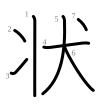Hello, you have come here looking for the meaning of the word
状. In DICTIOUS you will not only get to know all the dictionary meanings for the word
状, but we will also tell you about its etymology, its characteristics and you will know how to say
状 in singular and plural. Everything you need to know about the word
状 you have here. The definition of the word
状 will help you to be more precise and correct when speaking or writing your texts. Knowing the definition of
状, as well as those of other words, enriches your vocabulary and provides you with more and better linguistic resources.
Translingual
| Stroke order
|

|
Etymology
Simplified from 狀 (爿 → 丬).
Han character
状 (Kangxi radical 94, 犬+3, 7 strokes, cangjie input 中一戈大 (LMIK), composition ⿰丬犬)
- form
- appearance
- shape
- official
References
- Kangxi Dictionary: not present, would follow page 706, character 17
- Dai Kanwa Jiten: character 20257
- Dae Jaweon: page 1119, character 10
- Hanyu Da Zidian (first edition): volume 2, page 1332, character 3
- Unihan data for U+72B6
Chinese
For pronunciation and definitions of 状 – see 狀 (“form; appearance; state; shape; etc.”).
(This character is the simplified form of 狀). |
| Notes: |
Japanese
Kanji
状
(Fifth grade kyōiku kanji, shinjitai kanji, kyūjitai form 狀)
- condition
- form
- appearance
- letter
Readings
Compounds
Suffix
| Alternative spelling
|
| 狀 (kyūjitai)
|
状 • (-jō)
- being in such condition
- having such form or appearance
- letter, card, written notice
Korean
Hanja
状 • (jang, sang) (hangeul 장, 상, revised jang, sang, McCune–Reischauer chang, sang, Yale cang, sang)
- This term needs a translation to English. Please help out and add a translation, then remove the text
{{rfdef}}.
